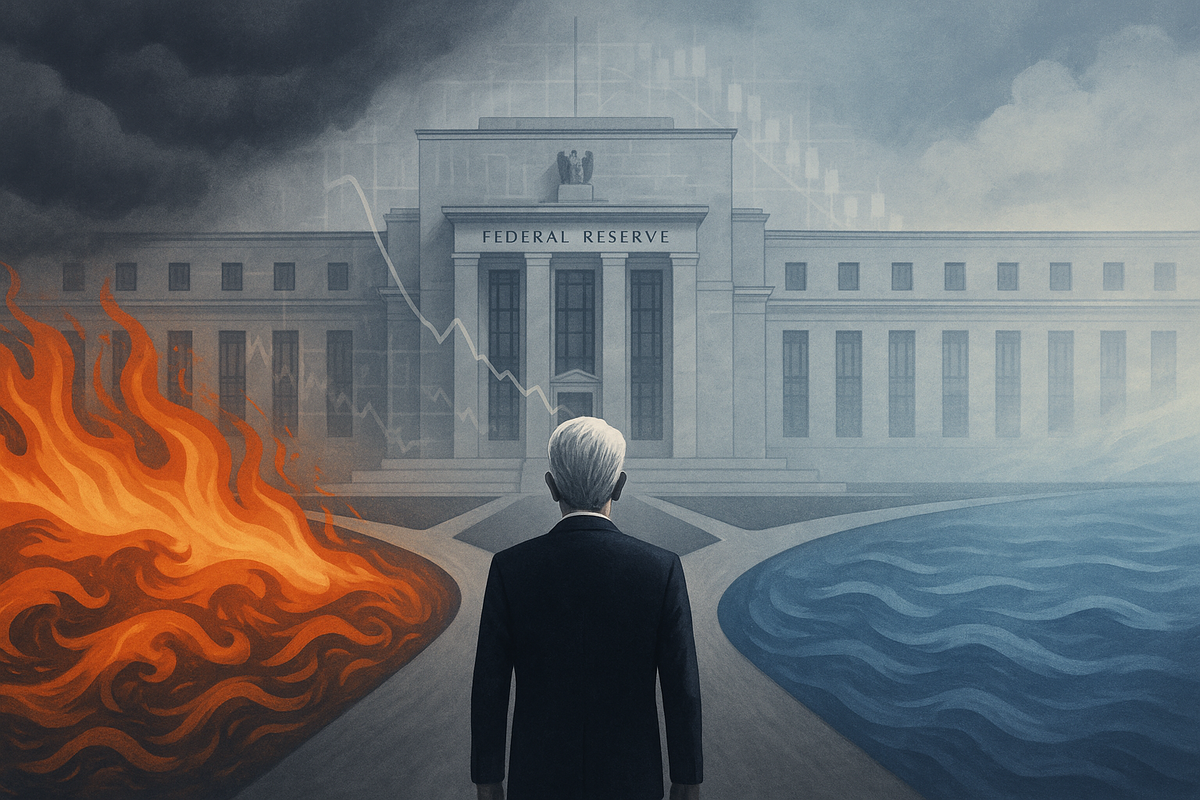
The financial world is abuzz with anticipation as the Federal Reserve grapples with a complex economic landscape, balancing persistent inflation concerns against a softening labor market. Market participants are keenly focused on the prospect of interest rate cuts, a sentiment further amplified by Federal Reserve Chair Jerome Powell's recent remarks at the prestigious Jackson Hole Economic Symposium. This delicate balancing act, coupled with internal dissent within the Federal Open Market Committee (FOMC), is shaping investor sentiment and setting the stage for potential shifts in monetary policy.
Current market expectations lean towards a cautious easing of monetary policy, with projections suggesting 2-3 potential rate cuts of 25 basis points each before the year's end. This marks a reduction from earlier, more aggressive forecasts, reflecting the Fed's data-dependent approach and the nuanced economic signals. The immediate implications are far-reaching, influencing everything from consumer borrowing costs to the performance of major financial markets.
Powell's Jackson Hole Address and the Shifting Sands of Monetary Policy
The Federal Reserve's target range for the federal funds rate has remained at 4.25%–4.50% since December 2024, a level maintained for five consecutive FOMC meetings. However, the narrative began to shift significantly following Chair Jerome Powell's keynote address at the 2025 Jackson Hole Economic Symposium on Friday, August 22nd. Powell, in what is expected to be his final Jackson Hole speech as Fed Chair, signaled an openness to potential interest rate cuts, stating that a slowing job market "may warrant" such adjustments. This statement provided a much-needed hint to markets, which had been pricing in a strong possibility of a September rate cut, with the CME's FedWatch tool indicating a 75.5% chance of a 25 basis point reduction.
However, Powell's message was not without its caveats. He cautioned that President Trump's trade policies continue to pose a threat of pushing inflation higher, noting that the effects of tariffs are "clearly visible" and are expected to "accumulate over coming months." This highlights the persistent tension within the Fed's dual mandate of achieving maximum employment and stable prices. The timeline leading up to this moment has been characterized by fluctuating expectations, driven by a mixed bag of economic data: inflation showing signs of moderation around 3% but still above the 2% target, and a labor market exhibiting resilient job additions but a gradually ticking up unemployment rate, with monthly job growth falling to an average of 35,000 since May.
Key players in this unfolding drama include the members of the FOMC, who have shown increasing internal division. For the first time since 1993, two Federal Reserve Governors, Michelle Bowman and Christopher Waller, openly dissented from the majority vote in July 2025, advocating for an immediate 25-basis-point interest rate cut. Their dissent stemmed from differing views on the impact of recent tariff policies on inflation and the labor market, with the dissenting governors arguing that the inflationary impact might be a one-time event, while labor market effects could be more structural. Despite this, the majority of the FOMC still viewed maintaining the current benchmark rate as appropriate. Initial market reactions to Powell's speech were largely positive, with major indices like the S&P 500 (SPX), Dow Jones Industrial Average (DJIA), and Nasdaq Composite (IXIC) surging, as investors interpreted his remarks as a green light for future easing.
Navigating the Tides: Potential Winners and Losers in a Rate-Cutting Environment
The prospect of Federal Reserve interest rate cuts creates a distinct landscape of potential winners and losers across various sectors of the economy and financial markets. Understanding these dynamics is crucial for investors and businesses alike.
Potential Winners:
- Growth Stocks and Highly Leveraged Companies: Lower interest rates generally translate to reduced borrowing costs, making it cheaper for companies to finance expansion, invest in new projects, and manage existing debt. This environment particularly benefits growth-oriented companies, often found in the technology sector, which rely on external financing for rapid expansion. Companies with significant debt loads could also see their interest expenses decrease, improving their profitability. For example, a tech giant like Microsoft (NASDAQ: MSFT) or a rapidly expanding startup could find it more economical to fund their initiatives.
- Real Estate and Housing Sector: While a single 25 basis point cut might have minimal immediate impact on mortgage rates, a sustained trend of rate reductions can gradually lower borrowing costs for homebuyers. This could stimulate demand in the housing market, benefiting homebuilders like D.R. Horton (NYSE: DHI) and real estate investment trusts (REITs) such as Prologis (NYSE: PLG), which often rely on debt for property acquisitions and development.
- Gold and Precious Metals: These assets often perform favorably in a rate-cutting environment. Lower interest rates reduce the opportunity cost of holding non-yielding assets like gold, making them more attractive to investors seeking a safe haven or a hedge against potential currency debasement. Gold prices have already shown record levels, and this trend could continue.
- Consumers: Lower interest rates translate to cheaper borrowing costs for credit cards, auto loans, and personal loans, putting more money back into consumers' pockets and potentially stimulating consumer spending, which benefits retail companies like Walmart (NYSE: WMT) and Amazon (NASDAQ: AMZN).
Potential Losers:
- Banks and Financial Institutions: While lower rates can stimulate lending, they can also compress net interest margins (NIMs) for banks, which is the difference between the interest they earn on loans and the interest they pay on deposits. A sustained period of lower rates could reduce profitability for institutions like JPMorgan Chase (NYSE: JPM) and Bank of America (NYSE: BAC), especially if deposit rates fall slower than lending rates.
- Savers: Individuals relying on interest income from savings accounts, money market accounts, and certificates of deposit (CDs) will likely see lower returns. This can disproportionately affect retirees and those on fixed incomes.
- U.S. Dollar: While bullish sentiment on the dollar has recently peaked, a series of rate cuts could potentially weaken the U.S. dollar against other major currencies, especially if other central banks maintain higher rates. This could make U.S. exports more competitive but imports more expensive.
The market's reaction to rate cuts is nuanced; if cuts are perceived as a preventative measure against economic weakness, the stock market generally reacts positively. However, if they are seen as a reaction to severe economic deterioration, the response could be negative. Given that many expectations are already priced in, actual implementation might lead to increased market volatility if the Fed's actions diverge from these expectations.
Broader Implications: A Data-Dependent Fed in a Politically Charged Environment
The Federal Reserve's current stance and the anticipated rate cuts fit into a broader trend of central banks globally navigating inflationary pressures and economic slowdowns. The Fed's data-dependent approach, repeatedly emphasized by officials, means that future policy adjustments will hinge on incoming economic data, the evolving outlook, and the balance of risks. This creates a dynamic environment where market expectations can shift rapidly with each new economic release.
The internal divisions within the FOMC highlight the complexity of the current economic landscape. While some members prioritize addressing potential labor market weakness, others remain wary of persistent inflation risks, particularly those stemming from tariffs. This internal disagreement underscores the challenge of achieving a consensus on the optimal path forward. The Fed is also operating under significant political pressure, with President Trump openly advocating for substantial rate cuts. This adds another layer of complexity, as the institution strives to maintain its independence while making critical policy decisions.
Historically, the Jackson Hole Economic Symposium has served as a crucial platform for signaling major shifts in monetary policy. From Paul Volcker's attendance in 1979, which established the event's credibility, to Ben Bernanke's 2010 speech signaling quantitative easing, and Jerome Powell's own announcement of a new policy framework in 2020, the symposium has consistently been a bellwether for global markets. Powell's recent speech, hinting at potential rate cuts while acknowledging tariff-driven inflation, continues this tradition, setting the tone for trading in fixed income and currency markets for the remainder of the year. The acknowledged impact of tariffs on consumer prices and the risk of "de-anchored" inflation expectations remain significant concerns for policymakers, potentially limiting the extent and speed of future rate reductions.
What Comes Next: Navigating Uncertainty and Adapting Strategies
Looking ahead, the financial markets are poised for a period of continued scrutiny and potential volatility as the Federal Reserve navigates its next steps. In the short term, all eyes will be on the upcoming FOMC meetings, particularly the September gathering, where a 25-basis-point rate cut is widely anticipated. The market will be dissecting every word from Fed officials for further clues regarding the pace and magnitude of future easing. Economic data releases, especially those pertaining to inflation, employment, and consumer spending, will play a pivotal role in shaping these expectations.
In the long term, the trajectory of interest rates will depend on the evolution of the economy, particularly the interplay between inflation and labor market conditions. Should inflation prove more stubborn than anticipated, or if the labor market shows unexpected resilience, the Fed might adopt a more cautious approach to rate cuts, potentially leading to fewer and smaller reductions than currently priced in by the market. Conversely, a more pronounced economic slowdown or a significant drop in inflation could accelerate the easing cycle.
Companies and investors will need to adapt their strategies to this evolving environment. Businesses might consider strategic pivots to optimize their debt structures, taking advantage of lower borrowing costs if rates decline. Those in interest-sensitive sectors, such as real estate and automotive, may see opportunities for increased demand. Investors, on the other hand, will need to carefully re-evaluate their portfolios, potentially shifting towards assets that perform well in a lower-rate environment, such as growth stocks and dividend-paying companies, while also considering hedges against potential market volatility. The possibility of the "neutral" interest rate being higher than pre-pandemic levels, as suggested by Powell, implies that even with cuts, rates might not return to the ultra-low levels seen in the past, which could temper expectations for aggressive easing.
Conclusion: A Cautious Path Forward for the Federal Reserve
The Federal Reserve stands at a critical juncture, with its anticipated interest rate cuts poised to significantly impact the economy and financial markets. Fed Chair Jerome Powell's recent speech at Jackson Hole, while signaling an openness to easing, also underscored the persistent challenges posed by inflation and geopolitical factors. The internal dissent within the FOMC further highlights the complexity of the current economic landscape, where policymakers are grappling with conflicting signals from the labor market and inflationary pressures.
The key takeaway for investors and the public is the Fed's unwavering commitment to a data-dependent approach. Future policy decisions will be meticulously guided by incoming economic data, making every inflation report and jobs number a market-moving event. While the market has largely priced in the start of rate cuts, the exact timing, magnitude, and duration of this easing cycle remain subject to ongoing economic developments and the nuanced interpretations of the Federal Reserve.
Moving forward, investors should closely monitor several key indicators: the monthly inflation reports, particularly the Consumer Price Index (CPI) and Personal Consumption Expenditures (PCE) price index; labor market data, including non-farm payrolls and the unemployment rate; and, of course, the official statements and minutes from FOMC meetings. The interplay of these factors will ultimately determine the Fed's path and, consequently, the trajectory of the financial markets in the coming months. The cautious optimism surrounding rate cuts is tempered by the reality of persistent economic uncertainties, demanding vigilance and adaptability from all market participants.






